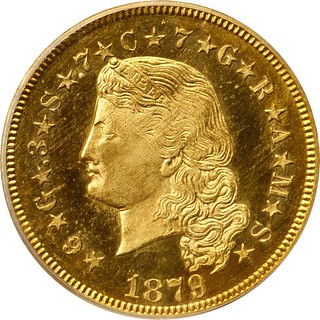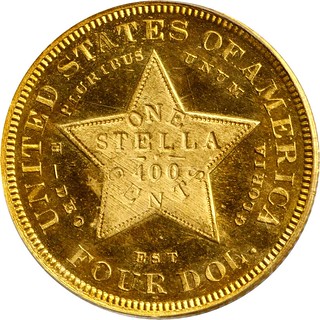
PREV ARTICLE
NEXT ARTICLE
FULL ISSUE
PREV FULL ISSUE
HOW THE $4 STELLAS CAME TO BEStack’s Bowers Galleries published a general-public press release this week with some interesting background on the creation of the U.S. $4 "Stella" gold patterns. Here's the main text of the release, followed by some more details from the online lot description. The piece is set to be sold November 14, 2019 at the Whitman Baltimore Winter Expo Rarities Night sale. -Editor   Valued at roughly $200,000, the Gold Stella was intended to be used as a universal coin that was to be exchangeable with any currency throughout the world. It’s weight and precious metals composition were designed to match the Latin Monetary Union, which set a bimetallic gold and silver standard at a fixed ratio of 15-1/2 to 1 and used the Napoleonic franc of 1803 as its basis. The Latin Monetary Union (LMU) was initially established between Belgium, France, Italy, and Switzerland, but was soon joined by many other continental European nations. Through the Union, one franc would be the same as one lira, peseta, leva, or drachma and easily exchangeable within the member nations. The Union proved to be successful and lasted until its dissolution in 1927. In many ways, the LMU was a precursor to the modern European Union founded in 1957. At the time of the establishment of the LMU, the United States was still reeling from the devastating effects of the Civil War, as well as the Panic of 1873. Fortunately, the economy proved resilient and by the later 1870s international trade increased at a steady rate. More and more Americans traveled abroad for both business and pleasure and found that the easy convertibility of the various currencies within the LMU made commerce more fluid. In 1877, Congressman John Kasson of Iowa was appointed by Rutherford Hayes as Envoy Extraordinary and Minister Plenipotentiary to the Austro-Hungarian Empire, where he was exposed to the difficulties in converting American dollars into Austrian florins and back again. When he returned, Kasson used his experiences - as well as influence as past chair of the House Committee on Coinage, Weights, and Measures - and submitted a proposal for a four-dollar coin that would be closer in weight to the Austro-Hungarian 8 florin piece, which was equivalent to the French 20 franc coin. Thus, the $4 Gold Stella was born. Two designs were prepared, the Flowing Hair design by Charles E. Barber, as here, and the Coiled Hair design by George T. Morgan, both of which became known as Stellas. Recent past Stack’s Bowers Galleries sales of the Flowing Hair and Coiled Hair Stellas garnered $400,000 and $646,000, respectively. Barber's Flowing Hair design was the first selected for production and an estimated 25 - though this may be a few as 10 to 15 - three-piece pattern Proof sets were prepared. These sets were distributed to Congressional leaders who took a liking to the unusual coins. Other government officials who encountered the coin pressed the Mint for more examples. To satisfy the demand, the Mint struck more examples in 1880 but all bearing the 1879 date. The precise number struck remains unclear, ranging from the traditionally quoted figure of 425 pieces to some estimates as high as 800 coins. Despite the interest in the coin, the denomination never received enough Congressional support to proceed with regular full-scale production. The denomination had no exact European counterpart due to the ratio of metals used not precisely matching LMU standards, was an unusual denomination, and seemed to have no real specific commercial use. In fact, many of the Stellas ended up being used as jewelry pieces and were the center of a scandal when, according to renowned researcher John Dannreuther, a number of them were found being worn by madams in Washington D.C. bordellos. “The Stella represents an attempt to integrate the world’s money as one,” said Brian Kendrella, President of Stack’s Bowers Galleries. “We still haven’t been able to do this even today but this coin represents the closest we likely ever came.” Here's some numismatic detail from the lot description. -Editor Despite the intention to produce the pattern Stellas in goloid as expressed by the obverse legend *6*G*.3*S*.7*C*7*G*R*A*M*S*, the coins were almost certainly produced in the standard alloy of 90% gold and 10% copper, though so far as known no Stella has been subjected to analysis to prove this assertion. On the reverse is the prominent large five-pointed star from which the coin earned its moniker and the denomination expressed three ways: ONE STELLA, 400 CENTS, and FOUR DOL. While most consideration was focused on the $4 gold piece, $20 "Quintuple Stella" patterns were also prepared along with metric silver and goloid dollars. Stellas were all struck as Proofs, but because many of the remaining coins ended up as pocket pieces or set into jewelry, they often appear as if they have seen very heavy circulation. Many are damaged with filed rims, scratches, and wear commensurate with long service in necklaces. The present coin is a noteworthy exception. I reached out to John Dannreuther for comments on the bordello reference. -Editor JD writes: I thought it was in a contemporary auction catalog, but I reread what I wrote and I said they "reputedly" were given, so evidently I could not find a reference, either! There are a lot of them that were used as jewelry. In fact, I once bought two coins that had already been used for jewelry (back when they were $7-10K for "damaged" ones). I had an order from a dealer who had a customer that was going to make them into cufflinks! To read the complete lot description, see:
 Wayne Homren, Editor The Numismatic Bibliomania Society is a non-profit organization promoting numismatic literature. See our web site at coinbooks.org. To submit items for publication in The E-Sylum, write to the Editor at this address: whomren@gmail.com To subscribe go to: https://my.binhost.com/lists/listinfo/esylum All Rights Reserved. NBS Home Page Contact the NBS webmaster 
|